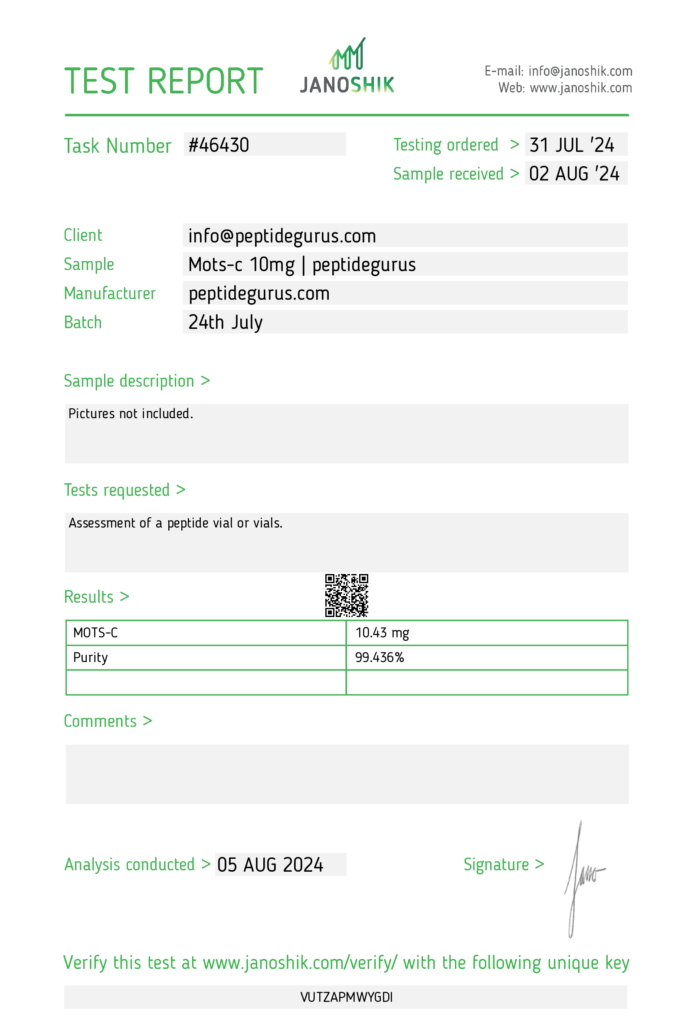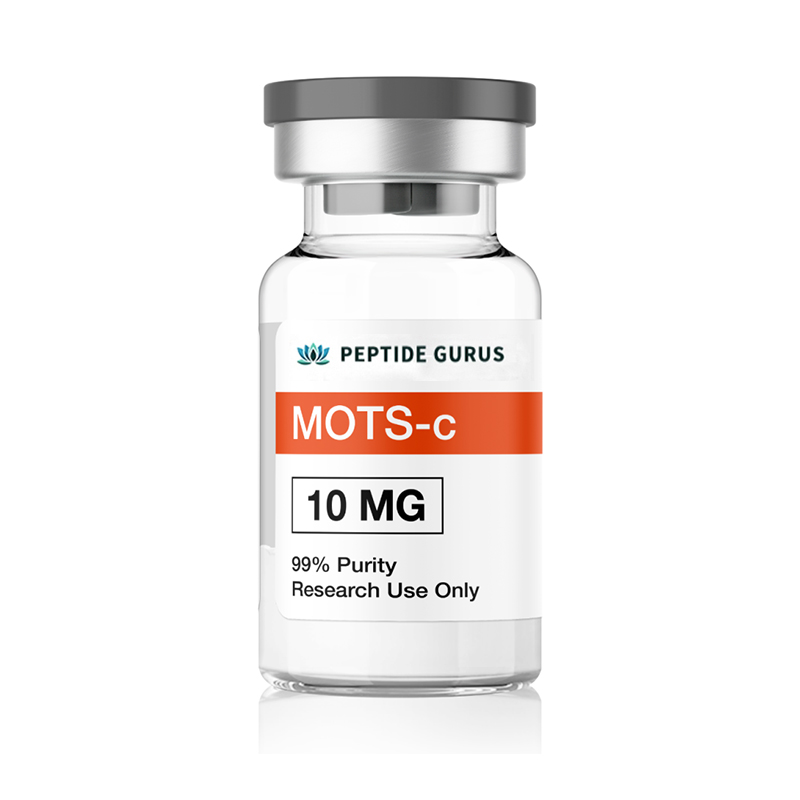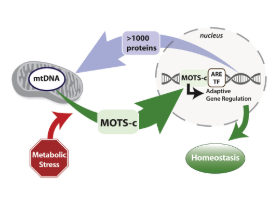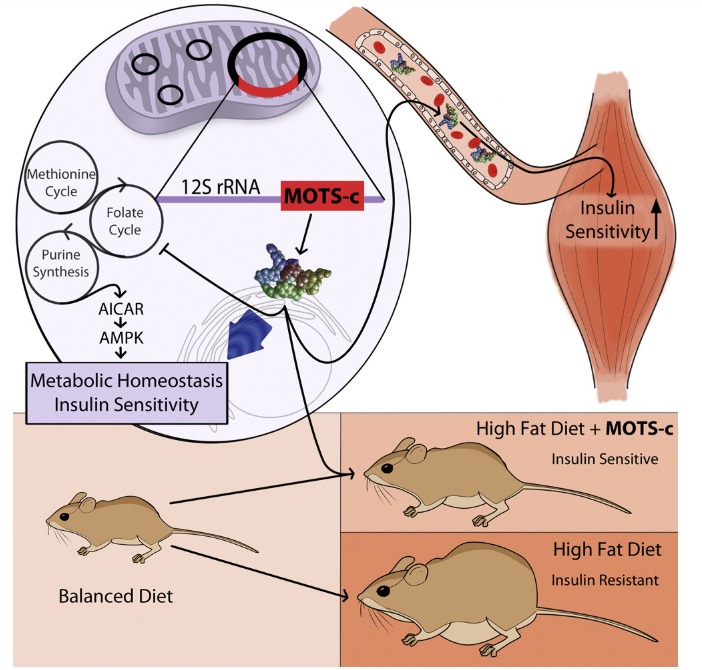




Categories: Peptide Finished product, Peptides and Their Dosages
Free (1) 30 ml Bacteriostatic Water
with qualified orders over $500 USD.
(excludes capsule products, cosmetic peptides, promo codes and shipping)
The Mitochondrial-Derived Peptide MOTS-c promotes metabolic homeostasis and longevity, improves exercise capacity, reduces obesity, insulin resistance and other disease processes such as osteoporosis.
Product Usage: This PRODUCT IS INTENDED AS A RESEARCH CHEMICAL ONLY. This designation allows the use of research chemicals strictly for in vitro testing and laboratory experimentation only. All product information available on this website is for educational purposes only. Bodily introduction of any kind into humans or animals is strictly forbidden by law. This product should only be handled by licensed, qualified professionals. This product is not a drug, food, or cosmetic and may not be misbranded, misused or mislabled as a drug, food or cosmetic.

Research in mice indicates the MOTS-c can reverse age-dependent insulin resistance in muscles, thereby improving muscle uptake of glucose. It does this by improving skeletal muscle response to AMPK activation, which in turn increases the expression of glucose transporters[1]. It is important to note that this activation is independent of the insulin pathway and thus offers an alternative means of boosting glucose uptake by muscles when insulin is ineffective or in insufficient quantity. The net result is improved muscle function, enhanced muscle growth, and decreased functional insulin resistance.
Research in mice has shown that low levels of estrogen lead to increased fat mass and dysfunction of normal adipose tissue. This scenario increases the risk of developing insulin resistance and, subsequently, the risk of developing diabetes. Supplementing mice with MOTS-c, however, increases brown fat function and reduces the accumulation of adipose tissue. It also appears that the peptide prevents adipose dysfunction and the adipose inflammation that typically precedes insulin resistance[2].
It appears that at least part of the influence that MOTS-c has on fat metabolism is mediated through activation of the AMPK pathway. This well-defined pathway is turned on when cellular energy levels are low and it drives the uptake of both glucose and fatty acids by cells for metabolism. It is also the pathway that is activated in ketogenic diets, like the Atkin’s diet, which promote fat metabolism while protecting lean body mass. MOTS-c targets the methionine-folate cycle, increases AICAR levels, and activates AMPK.
New research suggests that MOTS-c can actually leave the mitochondria and make its way to the nucleus where the peptide can affect nuclear gene expression. Following metabolic stress, MOTS-c has been shown to regulate nuclear genes involved in glucose restriction and antioxidant responses[3].

Evidence from mice indicates that MOTS-c, particularly in the setting of obesity, is an important regulator of sphingolipid, monoacylglycerol, and dicarboxylate metabolism. By down-regulating these pathways and increasing beta-oxidation, MOTS-c appears to prevent fat accumulation[4]. Some of these effects are almost certainly mediated via MOTS-c action in the nucleus. Research on MOTS-c has led to a new hypothesis about fat deposition and insulin resistance that is gaining traction in the scientific community and may offer a new means of intervening in the pathophysiology of obesity and diabetes. It appears that dysregulation of fat metabolism in mitochondria may result in a lack of fat oxidation. This leads to higher levels of circulating fat and thus forces the body to boost insulin levels in an effort to clear lipids from the bloodstream. The consequence of this action is increased fat deposition and a homeostatic change in the body as it adapts to (and becomes resistant to) chronically higher levels of insulin[5].

MOTS-c supplementation in rats prevents mitochondrial dysfunction and prevents the accumulation of fat even in the setting of a high-fat diet.
Source: Cell Metabolism
Research measuring MOTS-c levels in insulin sensitive and insulin resistant individuals has shown that the protein is associated with insulin sensitivity only in lean individuals. In other words, MOTS-c appears to be important in the pathogenesis of insulin insensitivity, but not in the maintenance of the condition[6]. Scientists speculate that the peptide maybe a useful means of monitoring pre-diabetic lean individuals and that changes in MOTS-c levels could act as an early warning sign of potential insulin insensitivity. Supplementation with MOTS-c in this setting could help to stave off insulin resistance and thus the development of diabetes. Research in mice thus far has been promising, but more work is needed to understand the full impact of MOTS-c on insulin regulation.
MOTS-c appears to play a role in the synthesis of type I collagen by osteoblasts in bone. Research in osteoblast cell lines shows that MOTS-c regulates the TGF-beta/SMAD pathway responsible for the health and survival of osteoblasts. By promoting osteoblast survival, MOTS-c helps to improve type I collagen synthesis and therefore the strength and integrity of bone[7].
Additional research in osteoporosis has revealed that MOTS-c promotes the differentiation of bone marrow stem cells via the same TGF-beta/SMAD pathway. In the study, this directly led to increased osteogenesis (formation of new bone)[8]. Thus, not only does MOTS-c protect osteoblasts and promote their survival, it promotes their development from stem cells as well.
Research on MOTS-c has identified a specific change in the peptide that is associated with longevity in certain human populations, such as the Japanese. The change in the MOTS-c gene, in this case, leads to the substitution of a glutamate residue for the lysine that is normally found in position 14 of the protein. It is not clear how this change affects the functional aspects of the protein, but that it does is almost certain as glutamate has radically different properties than lysine and thus would change both the structure and the function of the MOTS-c gene. More research is required to understand how this change affects function, but it is found exclusively in people with Northeast Asian ancestry and is thought to play a role in the exceptional longevity seen in this population[9].
According to Dr. Changhan David Lee, a researcher at the School of Gerontology at USC Leonard Davis, mitochondrial biology holds the keep to extending both lifespan and healthspan in humans. The mitochondria, being the single most important metabolic organelle, is “strongly implicated in aging and age-related diseases.” Until now, dietary restriction offered the only reliable means of affecting mitochondrial function and thus longevity. Peptides like MOTS-c, however, may make it possible to directly impact mitochondrial function in a more profound way.
Research measuring MOTS-c levels in humans undergoing coronary angiography has revealed that patients with lower levels of MOTS-c in the blood have higher levels of endothelial cell dysfunction. Endothelial cells line the inside of blood vessels and are integral to the regulation of blood pressure, blood clotting, and plaque formation. Additional research in rats suggests that while MOTS-c does not directly affect blood vessel responsiveness, it does sensitize endothelial cells to the effects of other signaling molecules, like acetylcholine. Supplementing rats with MOTS-c has been shown to improve endothelial function and improve microvascular and epicardial blood vessel function[10].
MOTS-c is not alone among mitochondria-derived peptides (MDPs) in affecting heart health. Research suggests that at least three MDPs play roles in protecting cardiac cells against stress and inflammation. There is good reason to believe that MDP dysregulation is also an important factor in the development of cardiovascular disease. The peptides may even be important factors in reperfusion injury and, as pointed out above, in endothelial function[11].
MOTS-c exhibits minimal side effects, low oral and excellent subcutaneous bioavailability in mice. Per kg dosage in mice does not scale to humans. MOTS-c for sale at Peptide Gurus is limited to educational and scientific research only, not for human consumption. Only buy MOTS-c if you are a licensed researcher.
The above literature was researched, edited and organized by Dr. Logan, M.D. Dr. Logan holds a doctorate degree from Case Western Reserve University School of Medicine and a B.S. in molecular biology.

Dr. Changhan David Lee, contributor to “MOTS-c: A novel mitochondrial-derived peptide regulating muscle and fat metabolism,” and “The Mitochondrial-Encoded Peptide MOTS-c Translocates to the Nucleus to Regulate Nuclear Gene Expression in Response to Metabolic Stress,” is a researcher at the School of Gerontology at USC Leonard Davis.
Pinchas Cohen, MD, is the dean of the USC Leonard Davis School of Gerontology, executive director of the Ethel Percy Andrus Gerontology Center, and holder of the William and Sylvia Kugel Dean’s Chair in Gerontology. He is an expert in the study of mitochondrial peptides and their possible therapeutic benefits for diabetes, Alzheimer’s, and other diseases related to aging. Cohen’s current research focus is on the emerging science of mitochondria-derived peptides, which he discovered. These peptides include humanin, a 24-amino acid peptide encoded from the mt-16S-rRNA. It is a novel, centrally acting insulin sensitizer and metaboloprotective factor representing a new therapeutic and diagnostic target in diabetes and related disease. Other mitochondrial peptides of interest include MOTS-c, a second peptide encoded from a small ORF in the 12S region of the mitochondrial chromosome that has potent anti-diabetes and anti-obesity effect and acts as an exercise-mimetic, and SHLP2, a peptide encoded from the light strand of the mt-16S-rRNA region whose levels correlate with prostate cancer.
Dr. Changhan David Lee and Dr. Pinchas Cohen are being referenced as leading scientists involved in the research and development of Humanin. In no way are these doctors/scientists endorsing or advocating the purchase, sale, or use of this product for any reason. There is no affiliation or relationship, implied or otherwise, between
ALL ARTICLES AND PRODUCT INFORMATION PROVIDED ON THIS WEBSITE ARE FOR INFORMATIONAL AND EDUCATIONAL PURPOSES ONLY.
The products offered on this website are furnished for in-vitro studies only. In-vitro studies (Latin: in glass) are performed outside of the body. These products are not medicines or drugs and have not been approved by the FDA to prevent, treat or cure any medical condition, ailment or disease. Bodily introduction of any kind into humans or animals is strictly forbidden by law.
PeptideGurus is a leading supplier of American-made research peptides, offering top-quality products at competitive prices. With a focus on excellence and customer service, they ensure a secure and convenient ordering process with global shipping.
CONTACT